11 apr 2016
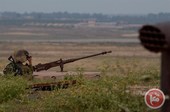
Israeli forces on Monday shot and injured a Palestinian boy in the central Gaza Strip.
Witnesses told Ma'an that Israeli forces deployed near Hujr al-Dik area in central Gaza Strip opened fire at a young teenager herding cattle, injuring him in the foot.
Medical sources identified him as Amir al-Tarabin,13, and said he was in moderate condition.
An Israeli army spokesperson didn’t immediately respond to a request for comment.
Israeli forces frequently open fire on Palestinians inside of or near a military-imposed “buffer zone” on both land and seaside borders of the besieged enclave.
The exact limits of the zone are unclear but enforced with live fire, putting the lives of Palestinian farmers and fishermen who work near the border at risk.
The Israeli army says the use of live fire is necessary to deter potential "security threats." However, the practice has destroyed much of both the agricultural and fishing sectors of the impoverished coastal enclave, which has been under Israeli blockade nearly nine years.
Witnesses told Ma'an that Israeli forces deployed near Hujr al-Dik area in central Gaza Strip opened fire at a young teenager herding cattle, injuring him in the foot.
Medical sources identified him as Amir al-Tarabin,13, and said he was in moderate condition.
An Israeli army spokesperson didn’t immediately respond to a request for comment.
Israeli forces frequently open fire on Palestinians inside of or near a military-imposed “buffer zone” on both land and seaside borders of the besieged enclave.
The exact limits of the zone are unclear but enforced with live fire, putting the lives of Palestinian farmers and fishermen who work near the border at risk.
The Israeli army says the use of live fire is necessary to deter potential "security threats." However, the practice has destroyed much of both the agricultural and fishing sectors of the impoverished coastal enclave, which has been under Israeli blockade nearly nine years.
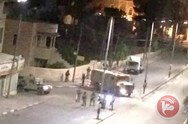
Clashes broke out overnight Sunday in the Aida and Azza refugee camps in Bethlehem between Palestinian youth and Israeli forces, during widespread Israeli army raids across the occupied West Bank in which at least 18 Palestinians were detained, including a Palestinian security officer.
Local sources said Israeli forces stormed Aida refugee camp in the southern occupied district of Bethlehem, firing gunshots and tear gas canisters, while Palestinians shouted “Allah Akbar” (God is great) and whistled at Israeli forces.
Witnesses told Ma’an masked Palestinian gunmen exchanged fire with Israeli soldiers near the Abu Bakr mosque in Aida. No casualties were reported.
Israeli troops also raided the nearby Azza refugee camp firing tear gas canisters, according to eyewitnesses.
An Israeli army spokesperson told Ma’an four Palestinians were detained in the district of Bethlehem. Locals added another was issued a summons.
Israeli forces also detained Palestinian security officer Muhannad Farah Salih Barghouthi from the village of Beit Rima west of Ramallah in the central occupied West Bank.
His brother told Ma’an that Barghouthi -- an officer in the Palestinian Authority’s national security service -- was driving his private car from Jericho back to Ramallah when Israeli soldiers stopped him and took him into custody.
He added that Barghouthi was released from Israeli custody two years ago after serving an eight-year sentence.
Israeli forces also detained six other Palestinians in the central West Bank district of Ramallah, two Palestinians in the northern West Bank district of Jenin, three in the northern West Bank district of Nablus, and two in the southern West Bank district of Hebron, according to the Israeli army spokesperson.
According to prisoners’ rights group Addameer, 7,000 Palestinians were held in Israeli prisons as of February.
The majority were detained in predawn detention raids carried out by the Israeli military, including in areas supposedly under full Palestinian jurisdiction according to the Oslo Accords.
Such raids often lead to clashes between locals and Israeli military forces entering their communities, regularly resulting in injury and sometimes death of Palestinian residents.
Local sources said Israeli forces stormed Aida refugee camp in the southern occupied district of Bethlehem, firing gunshots and tear gas canisters, while Palestinians shouted “Allah Akbar” (God is great) and whistled at Israeli forces.
Witnesses told Ma’an masked Palestinian gunmen exchanged fire with Israeli soldiers near the Abu Bakr mosque in Aida. No casualties were reported.
Israeli troops also raided the nearby Azza refugee camp firing tear gas canisters, according to eyewitnesses.
An Israeli army spokesperson told Ma’an four Palestinians were detained in the district of Bethlehem. Locals added another was issued a summons.
Israeli forces also detained Palestinian security officer Muhannad Farah Salih Barghouthi from the village of Beit Rima west of Ramallah in the central occupied West Bank.
His brother told Ma’an that Barghouthi -- an officer in the Palestinian Authority’s national security service -- was driving his private car from Jericho back to Ramallah when Israeli soldiers stopped him and took him into custody.
He added that Barghouthi was released from Israeli custody two years ago after serving an eight-year sentence.
Israeli forces also detained six other Palestinians in the central West Bank district of Ramallah, two Palestinians in the northern West Bank district of Jenin, three in the northern West Bank district of Nablus, and two in the southern West Bank district of Hebron, according to the Israeli army spokesperson.
According to prisoners’ rights group Addameer, 7,000 Palestinians were held in Israeli prisons as of February.
The majority were detained in predawn detention raids carried out by the Israeli military, including in areas supposedly under full Palestinian jurisdiction according to the Oslo Accords.
Such raids often lead to clashes between locals and Israeli military forces entering their communities, regularly resulting in injury and sometimes death of Palestinian residents.
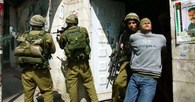
Several Palestinians were kidnapped and others were injured in a mass-abduction sweep launched by the Israeli occupation forces (IOF) across the West Bank at dawn Monday.
Reporting from Nablus, a PIC news correspondent said the IOF rolled into the city and kidnapped 23-year-old university student Malek Bilal Eshtiyeh from his own family home in Tel town, to the west.
The Israeli occupation troops attacked the Palestinian protesters with heavy spates of tear gas canisters during the clashes that flared up following the assault.
Another student was kidnapped from Beit Iba town, in western Nablus. The occupation troops reportedly wreaked havoc on civilian homes across the town. The IOF further stormed the Aida refugee camp, in northern Bethlehem city, at the crack of dawn, sparking clashes with anti-occupation youths.
The IOF attacked the Palestinians with live rounds and teargas canisters, resulting in several suffocation cases. Red Cross crews said the occupation troops denied them access into the camp to assist a Palestinian civilian who sustained live bullet wounds in the attack.
A similar Israeli campaign rocked the Arroub refugee camp for Palestinian refugees, in northern al-Khalil. The IOF also rummaged into civilian homes before they kidnapped two Palestinian youngsters and dragged them to an unidentified destination. Three youngsters were summoned for questioning in the Etzion detention center.
The IOF also raided Dura town and ravaged a charity association for Palestinian orphans before they confiscated equipment and a set of documents. Several Palestinians were summoned for interrogation in al-Khalil’s southern neighborhoods.
Reporting from Nablus, a PIC news correspondent said the IOF rolled into the city and kidnapped 23-year-old university student Malek Bilal Eshtiyeh from his own family home in Tel town, to the west.
The Israeli occupation troops attacked the Palestinian protesters with heavy spates of tear gas canisters during the clashes that flared up following the assault.
Another student was kidnapped from Beit Iba town, in western Nablus. The occupation troops reportedly wreaked havoc on civilian homes across the town. The IOF further stormed the Aida refugee camp, in northern Bethlehem city, at the crack of dawn, sparking clashes with anti-occupation youths.
The IOF attacked the Palestinians with live rounds and teargas canisters, resulting in several suffocation cases. Red Cross crews said the occupation troops denied them access into the camp to assist a Palestinian civilian who sustained live bullet wounds in the attack.
A similar Israeli campaign rocked the Arroub refugee camp for Palestinian refugees, in northern al-Khalil. The IOF also rummaged into civilian homes before they kidnapped two Palestinian youngsters and dragged them to an unidentified destination. Three youngsters were summoned for questioning in the Etzion detention center.
The IOF also raided Dura town and ravaged a charity association for Palestinian orphans before they confiscated equipment and a set of documents. Several Palestinians were summoned for interrogation in al-Khalil’s southern neighborhoods.
10 apr 2016
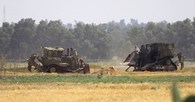
Several Israeli army jeeps on Sunday morning launched a limited incursion into eastern Gaza and Rafah cities, in the blockaded Gaza Strip.
A PIC news correspondent said an Israeli army patrol escorted by six bulldozers moved some 50 meters into Palestinian lands in eastern al-Shujaiya neighborhood and raked through Palestinians’ cultivated lands.
Other Israeli army bulldozers also rolled into eastern al-Nahdha neighborhood, in Rafah city, to the south of the blockaded Gaza Strip. Sounds of intermittent gunshots were detected all the way through the incursion.
Meanwhile, reports were released on the abduction of Palestinian youth by the Israeli occupation soldiers near Gaza’s border fence. Israeli news outlets claimed the abduction was carried out after the youth crept into the border fence separating Gaza from 1948 Occupied Palestine.
A PIC news correspondent said an Israeli army patrol escorted by six bulldozers moved some 50 meters into Palestinian lands in eastern al-Shujaiya neighborhood and raked through Palestinians’ cultivated lands.
Other Israeli army bulldozers also rolled into eastern al-Nahdha neighborhood, in Rafah city, to the south of the blockaded Gaza Strip. Sounds of intermittent gunshots were detected all the way through the incursion.
Meanwhile, reports were released on the abduction of Palestinian youth by the Israeli occupation soldiers near Gaza’s border fence. Israeli news outlets claimed the abduction was carried out after the youth crept into the border fence separating Gaza from 1948 Occupied Palestine.
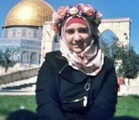
Journalist Samah Dweik
Israeli soldiers kidnapped, late at night and on Sunday at dawn, at least eleven Palestinians, including children and a journalist, in different parts of the occupied West Bank, and summoned many for interrogation in a number of military centers.
The soldiers also invaded and bulldozed farmlands, in Gaza.
Several military vehicles invaded Silwad town, east of the central West bank city of Ramallah, searched many homes and kidnapped three Palestinians, identified as Saif Khalil Hammad, 19, Bilal Sobhi Hamed, 17, and Mo’men Bassem Hamed, 17.
The soldiers also invaded the home of Taleb Hamed, looking for his son, Tareq, 19, but he was not at home; he is a student of Birzeit University.
A university student, identified as Bahaeddin Sheja’eyya, 19, was kidnapped after the soldiers invaded his home in Deir Jarir town, east of Ramallah.
The soldiers also invaded Zawiya town, in the central West Bank district of Salfit, and kidnapped one Palestinian, identified as Monir Shaqqoura.
In the southern West Bank district of Hebron, the soldiers kidnapped Tamer Waleed Ghazi, 17, from the al-‘Arroub refugee camp, Monir Nasser Shadeed, 20, from Doura town, and Husam al-Misk, a student of the Al-Quds – Abu Dis University.
The soldiers also summoned for interrogation the head of Palestine Detainees’ Center Osama Shahin, and Jaber Rajoub, from Doura, in addition to a former political prisoner, identified as Zeid Abu Fannar, in Yatta town.
In occupied Jerusalem, the soldiers kidnapped a child, identified as Mohammad Ishaq Taha, 15, from his home in Qotna town.
Another Palestinian, who remained unidentified until the time of this report, was kidnapped from his home in Rafat town, north of Jerusalem.
The soldiers also kidnapped Palestinian journalist, identified as Samah Dweik, 25, after invading her home in Ras al-‘Amoud neighborhood in Silwan town, in Jerusalem, and confiscated her computer and other equipment.
It is worth mentioning that Samah, a reporter with Quds News Network, is “blacklisted” by Israel, and has been denied access to the Al-Aqsa Mosque, in Jerusalem, for the past several homes.
In addition, several Israeli military vehicles and bulldozers invaded Palestinian agricultural lands, close to the border fence near the Sheja’eyya neighborhood, east of Gaza city, before uprooting them. The soldiers also fired a number of rounds of live ammunition.
The Israeli vehicles also invaded lands in the Nahda neighborhood, in Rafah, in the southern part of the Gaza Strip; the invasion in the fifth in the last five days.
Israeli soldiers kidnapped, late at night and on Sunday at dawn, at least eleven Palestinians, including children and a journalist, in different parts of the occupied West Bank, and summoned many for interrogation in a number of military centers.
The soldiers also invaded and bulldozed farmlands, in Gaza.
Several military vehicles invaded Silwad town, east of the central West bank city of Ramallah, searched many homes and kidnapped three Palestinians, identified as Saif Khalil Hammad, 19, Bilal Sobhi Hamed, 17, and Mo’men Bassem Hamed, 17.
The soldiers also invaded the home of Taleb Hamed, looking for his son, Tareq, 19, but he was not at home; he is a student of Birzeit University.
A university student, identified as Bahaeddin Sheja’eyya, 19, was kidnapped after the soldiers invaded his home in Deir Jarir town, east of Ramallah.
The soldiers also invaded Zawiya town, in the central West Bank district of Salfit, and kidnapped one Palestinian, identified as Monir Shaqqoura.
In the southern West Bank district of Hebron, the soldiers kidnapped Tamer Waleed Ghazi, 17, from the al-‘Arroub refugee camp, Monir Nasser Shadeed, 20, from Doura town, and Husam al-Misk, a student of the Al-Quds – Abu Dis University.
The soldiers also summoned for interrogation the head of Palestine Detainees’ Center Osama Shahin, and Jaber Rajoub, from Doura, in addition to a former political prisoner, identified as Zeid Abu Fannar, in Yatta town.
In occupied Jerusalem, the soldiers kidnapped a child, identified as Mohammad Ishaq Taha, 15, from his home in Qotna town.
Another Palestinian, who remained unidentified until the time of this report, was kidnapped from his home in Rafat town, north of Jerusalem.
The soldiers also kidnapped Palestinian journalist, identified as Samah Dweik, 25, after invading her home in Ras al-‘Amoud neighborhood in Silwan town, in Jerusalem, and confiscated her computer and other equipment.
It is worth mentioning that Samah, a reporter with Quds News Network, is “blacklisted” by Israel, and has been denied access to the Al-Aqsa Mosque, in Jerusalem, for the past several homes.
In addition, several Israeli military vehicles and bulldozers invaded Palestinian agricultural lands, close to the border fence near the Sheja’eyya neighborhood, east of Gaza city, before uprooting them. The soldiers also fired a number of rounds of live ammunition.
The Israeli vehicles also invaded lands in the Nahda neighborhood, in Rafah, in the southern part of the Gaza Strip; the invasion in the fifth in the last five days.

Israeli gunboats on Saturday evening opened machinegun fire at Palestinian fishermen and their boats off the coast of Beit Lahiya district, north of the besieged Gaza Strip.
The coastal police in Gaza said that the fishermen were attacked as they were working within the permitted six-nautical-mile fishing zone.
They added that the shooting was so intensive and forced the fishing boats to return ashore, pointing out that no one was hurt in the attack.
Gunfire attacks on fishermen, farmers and civilians in Gaza have become part of routine violations since Israel accepted an Egyptian-brokered ceasefire agreement in 2014.
The coastal police in Gaza said that the fishermen were attacked as they were working within the permitted six-nautical-mile fishing zone.
They added that the shooting was so intensive and forced the fishing boats to return ashore, pointing out that no one was hurt in the attack.
Gunfire attacks on fishermen, farmers and civilians in Gaza have become part of routine violations since Israel accepted an Egyptian-brokered ceasefire agreement in 2014.
9 apr 2016
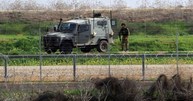
Israeli occupation forces (IOF) opened fire at Palestinian shepherds to the east of Rafah city in southern Gaza Strip on Saturday.
Local sources said that the soldiers shot at the shepherds while tending to their sheep grazing in nearby pastures, adding that no casualties were reported in the incident.
Local sources said that the soldiers shot at the shepherds while tending to their sheep grazing in nearby pastures, adding that no casualties were reported in the incident.
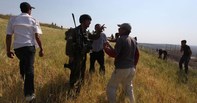
Israeli Occupation Forces (IOF) stopped Friday evening a number of Palestinian farmers from working in their land east of Salem town in the northern West Bank city of Nablus.
Eyewitnesses said that the farmers were removing weeds from their land and grazing their cattle when Israeli forces stormed the area and forced them to leave at gunpoint.
Last month, Israeli settlers stormed the area and uprooted dozens of olive trees under the protection of Israeli forces.
Despite living under a brutal military occupation, Palestinian towns and villages located near illegal Israeli settlements are subjected to regular settlers’ attacks and violations under the protection of Israeli forces.
Eyewitnesses said that the farmers were removing weeds from their land and grazing their cattle when Israeli forces stormed the area and forced them to leave at gunpoint.
Last month, Israeli settlers stormed the area and uprooted dozens of olive trees under the protection of Israeli forces.
Despite living under a brutal military occupation, Palestinian towns and villages located near illegal Israeli settlements are subjected to regular settlers’ attacks and violations under the protection of Israeli forces.
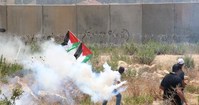
Israeli soldiers shot and injured, on Friday, at least ten Palestinians, including four with live fire, in the Gaza Strip.
Medical sources said two Palestinians were shot with live rounds after the soldiers, stationed across the border fence, opened fire on dozens of protesters.
The two were moved to the Shifa Hospital suffering moderate wounds.
The clashes took place east of the Sheja’eyya neighborhood, east of Gaza city; the soldiers who opened fire on them were stationed in the Nahal Oz military base, across the border fence.
The sources added that scores of residents suffered the effects of tear gas inhalation, and received the required treatment without the need for hospitalization.
Two Palestinians were also shot with live Israeli army fire east of the al-Boreij refugee camp, in central Gaza, and were moved to a nearby hospital.
IOF shoots, injures Palestinian protesters in W.B., Gaza
At least seven Palestinians were injured while dozens suffered effects of teargas inhalation after clashes erupted in the West Bank and Gaza when Israeli Occupation Forces (IOF) suppressed weekly marches.
Dozens of Palestinians and foreign activists suffered effects of tear gas inhalation, while at least one was shot by rubber-coated steel bullet when Israeli forces brutally attacked the weekly peaceful march of Bil’in with teargas bombs and rubber bullets.
The local activist Rateb Abu Rahma said that head of the village council Bassil Mansour was hit with a rubber-coated steel bullet during the march. Large agricultural lands and dozens of olive and almond trees were burned due to the excessive use of teargas bombs, he added.
Similar clashes broke out as IOF soldiers violently suppressed Ni’lin peaceful march west of Ramallah shortly after Friday prayers. The participants waved Palestinian flags and chanted slogans calling for restoring their confiscated lands.
During the clashes, one young man was moderately injured after being shot with a rubber bullet in his abdomen while dozens others choked on tear gas.
Along the same line, three Palestinians were shot with rubber bullets while nearly 20 others choked on teargas during Kafer Qaddum anti-settlement march. Israeli forces fired a barrage of metal bullets and tear gas towards the participants, causing dozens of injuries among them.
Similar confrontations broke out in Azba village when Israeli forces violently attacked an anti-occupation march with teargas bombs and rubber bullets. Two young men were injured during the clashes while dozens choked on teargas.
A Palestinian and four foreign activists were also arrested during the events and taken to a nearby military camp. In Gaza, three Palestinians were injured on Friday with live fire when clashes erupted with Israeli forces in border areas in the northern and eastern Gaza Strip.
Medical sources said that two citizens were moderately injured with live fire near the Israeli-controlled Nahal Oz crossing east of al-Shujayyia neighborhood.
A third young man was also injured in similar clashes near Bureij refugee camp in central Gaza Strip. Palestinians in the Gaza Strip demonstrate near the border areas every Friday in support the Jerusalem Intifada taking place in occupied West Bank and Jerusalem.
Medical sources said two Palestinians were shot with live rounds after the soldiers, stationed across the border fence, opened fire on dozens of protesters.
The two were moved to the Shifa Hospital suffering moderate wounds.
The clashes took place east of the Sheja’eyya neighborhood, east of Gaza city; the soldiers who opened fire on them were stationed in the Nahal Oz military base, across the border fence.
The sources added that scores of residents suffered the effects of tear gas inhalation, and received the required treatment without the need for hospitalization.
Two Palestinians were also shot with live Israeli army fire east of the al-Boreij refugee camp, in central Gaza, and were moved to a nearby hospital.
IOF shoots, injures Palestinian protesters in W.B., Gaza
At least seven Palestinians were injured while dozens suffered effects of teargas inhalation after clashes erupted in the West Bank and Gaza when Israeli Occupation Forces (IOF) suppressed weekly marches.
Dozens of Palestinians and foreign activists suffered effects of tear gas inhalation, while at least one was shot by rubber-coated steel bullet when Israeli forces brutally attacked the weekly peaceful march of Bil’in with teargas bombs and rubber bullets.
The local activist Rateb Abu Rahma said that head of the village council Bassil Mansour was hit with a rubber-coated steel bullet during the march. Large agricultural lands and dozens of olive and almond trees were burned due to the excessive use of teargas bombs, he added.
Similar clashes broke out as IOF soldiers violently suppressed Ni’lin peaceful march west of Ramallah shortly after Friday prayers. The participants waved Palestinian flags and chanted slogans calling for restoring their confiscated lands.
During the clashes, one young man was moderately injured after being shot with a rubber bullet in his abdomen while dozens others choked on tear gas.
Along the same line, three Palestinians were shot with rubber bullets while nearly 20 others choked on teargas during Kafer Qaddum anti-settlement march. Israeli forces fired a barrage of metal bullets and tear gas towards the participants, causing dozens of injuries among them.
Similar confrontations broke out in Azba village when Israeli forces violently attacked an anti-occupation march with teargas bombs and rubber bullets. Two young men were injured during the clashes while dozens choked on teargas.
A Palestinian and four foreign activists were also arrested during the events and taken to a nearby military camp. In Gaza, three Palestinians were injured on Friday with live fire when clashes erupted with Israeli forces in border areas in the northern and eastern Gaza Strip.
Medical sources said that two citizens were moderately injured with live fire near the Israeli-controlled Nahal Oz crossing east of al-Shujayyia neighborhood.
A third young man was also injured in similar clashes near Bureij refugee camp in central Gaza Strip. Palestinians in the Gaza Strip demonstrate near the border areas every Friday in support the Jerusalem Intifada taking place in occupied West Bank and Jerusalem.
8 apr 2016
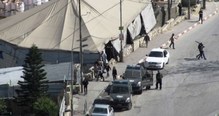
The Israeli occupation forces (IOF) on Friday kidnapped six Palestinians and destroyed sit-in tents in Occupied Jerusalem.
The abduction was carried out as dozens of Muslim worshipers performed Friday’s noon prayers in Ein al-Louza, to the south of the holy al-Aqsa Mosque, in protest at an Israeli decision to demolish 50 Palestinian homes in favor of Israeli parks.
A PIC journalist said the IOF rolled into the area before noon time and kidnapped six Palestinian youths shortly before they confiscated a sit-in tent.
A series of protest moves is to be staged by Palestinian locals in response to Israel’s schemes of forced displacement and ethnic cleansing in favor of Israeli settlement expansion.
Eyewitnesses said heavily-armed Israeli troops showed up at the scene and ruined the tent before they confiscated a vehicle. Activist Maysaa Abu Ghazala also said the occupation police arrested the head of the Wadi Hilweh Information Center, Jawad Seyam, and dragged him to the Salah Al-Deen detention center, in Occupied Jerusalem.
Last Friday the IOF quelled a sit-in staged by Palestinian worshipers in Ein al-Louza and Batn al-Hawa neighborhoods, in Silwan, and attacked the protesters with randomly-shot spates of teargas canisters.
The abduction was carried out as dozens of Muslim worshipers performed Friday’s noon prayers in Ein al-Louza, to the south of the holy al-Aqsa Mosque, in protest at an Israeli decision to demolish 50 Palestinian homes in favor of Israeli parks.
A PIC journalist said the IOF rolled into the area before noon time and kidnapped six Palestinian youths shortly before they confiscated a sit-in tent.
A series of protest moves is to be staged by Palestinian locals in response to Israel’s schemes of forced displacement and ethnic cleansing in favor of Israeli settlement expansion.
Eyewitnesses said heavily-armed Israeli troops showed up at the scene and ruined the tent before they confiscated a vehicle. Activist Maysaa Abu Ghazala also said the occupation police arrested the head of the Wadi Hilweh Information Center, Jawad Seyam, and dragged him to the Salah Al-Deen detention center, in Occupied Jerusalem.
Last Friday the IOF quelled a sit-in staged by Palestinian worshipers in Ein al-Louza and Batn al-Hawa neighborhoods, in Silwan, and attacked the protesters with randomly-shot spates of teargas canisters.
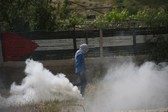
Israeli soldiers attacked, Friday, dozens of Palestinian, Israeli and international peace activists holding the weekly nonviolent protest in Bil’in village, near the central West Bank city of Ramallah. This week’s protest commemorates the 68th anniversary of Deir Yassin Massacre.
The Popular Committee Against the Wall and Settlements, in Bil’in, said the protesters marched in the village, carrying Palestinian flags, chanting for national unity, in addition to calling for removing all Israeli colonies from occupied Palestine, ongoing resistance and the release of all detainees.
Israeli soldiers fired rubber-coated steel bullets, gas bombs, and concussion grenades on the protesters and chased many of them in the Palestinian orchards.
The Popular Committee said that the head of Bil’in village Council Bassel Mansour, 40, was shot with a gas bomb in his leg, while dozens of locals, Israeli and international peace activists suffered the effects of tear gas inhalation.
Israeli gas bombs and concussion grenades also led to fires in large areas of olive orchards and lands planted with almond trees, belonging to residents Haitham Khatib and Nasser Abu Rahma.
The Popular Committee in Bil’in said that, as the Palestinians mark the 68th anniversary of Deir Yassin massacre, the history of the Israeli occupation continues to be a history of massacres and war crimes against the Palestinians, their homes and lands.
It also called on the local and international, legal and human rights group to ensure the prosecution of Israel in international courts for its ongoing crimes against the Palestinian people.
Deir Yassin Massacre took place on April 9 1948, when the Irgun and Stern terrorist Zionist armed organizations attacked the village of about 750 Palestinian inhabitants and killed more than 250-350 men, women and children; fifty-three orphaned children were left along the wall of the Old City.
The Popular Committee Against the Wall and Settlements, in Bil’in, said the protesters marched in the village, carrying Palestinian flags, chanting for national unity, in addition to calling for removing all Israeli colonies from occupied Palestine, ongoing resistance and the release of all detainees.
Israeli soldiers fired rubber-coated steel bullets, gas bombs, and concussion grenades on the protesters and chased many of them in the Palestinian orchards.
The Popular Committee said that the head of Bil’in village Council Bassel Mansour, 40, was shot with a gas bomb in his leg, while dozens of locals, Israeli and international peace activists suffered the effects of tear gas inhalation.
Israeli gas bombs and concussion grenades also led to fires in large areas of olive orchards and lands planted with almond trees, belonging to residents Haitham Khatib and Nasser Abu Rahma.
The Popular Committee in Bil’in said that, as the Palestinians mark the 68th anniversary of Deir Yassin massacre, the history of the Israeli occupation continues to be a history of massacres and war crimes against the Palestinians, their homes and lands.
It also called on the local and international, legal and human rights group to ensure the prosecution of Israel in international courts for its ongoing crimes against the Palestinian people.
Deir Yassin Massacre took place on April 9 1948, when the Irgun and Stern terrorist Zionist armed organizations attacked the village of about 750 Palestinian inhabitants and killed more than 250-350 men, women and children; fifty-three orphaned children were left along the wall of the Old City.
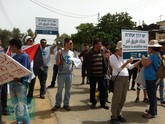
Israeli soldiers prevent on Friday a joint Israeli-Palestinian peaceful demonstration against the seizing of private Palestinian lands. The demonstration, led by activists from ‘Combatants for Peace’ movement, is part of the resident’s struggle against the plan to build the Nabi-Alias bypass road to benefit settlers, on private Palestinian lands.
Even before the non-violent demonstration could begin, protesters were met with military and border police forces which showed them a Closed Military Zone warrant, which was issued for that specific day only, in order to prevent the protest.
Most of the demonstrators were able to meet in the village of Izbat al-Tabib near Nabi Elias and began to march towards the exit of the village, but were met there with troops who blocked the exit to the village. There the demonstrators tried to plant olive tree as a symbol of peace, but the soldiers attacked using tear gas and rubber-coated steel bullets. Two Palestinian protesters were wounded by rubber bullets and two others suffered from tear gas inhalation.
Troops also detained four Israeli and one Palestinian activists Two Palestinian protesters were wounded by rubber bullets and two others suffered from tear gas inhalation.
Maya Katz, Combatants for Peace activist who took part in the demonstration: “The right to protest is denied even from non-violent peace activists, who came to demonstrate against the construction of a road that will benefit only the settlers on private Palestinian land, and to plant an olive tree as a symbol of peace. Without any provocation, the army used extreme means to stop the protest and arrested activists in suppression of the freedom of speech “.
In order to build the Nabi Alias bypass road, which will serve mostly settlers’ needs of separation from the Palestinian population and has no benefit for Palestinians, 104 dunam of private Palestinian landshas been expropriated in December 2015. If this plan continues, 700 olive trees would be uprooted and the agricultural landscape would be damaged, as would the livelihood of Palestinian farmers and small business owners. Demolition of Palestinian shops located in the future roads’ area began this week.
Combatants for Peace was formed by Israelis and Palestinians who took part in the cycle of violence in our region and are now working together in non-violent ways for peace and coexistence. In recent years, the movement has conducted hundreds of activities, house meetings with ex-combatants, tours, demonstrations and lectures, both in Israel and Palestine. The movement calls for ending the occupation, rejects any kind of violence on both sides, and the recognition of the existence of a dialogue partner on the other side.
Even before the non-violent demonstration could begin, protesters were met with military and border police forces which showed them a Closed Military Zone warrant, which was issued for that specific day only, in order to prevent the protest.
Most of the demonstrators were able to meet in the village of Izbat al-Tabib near Nabi Elias and began to march towards the exit of the village, but were met there with troops who blocked the exit to the village. There the demonstrators tried to plant olive tree as a symbol of peace, but the soldiers attacked using tear gas and rubber-coated steel bullets. Two Palestinian protesters were wounded by rubber bullets and two others suffered from tear gas inhalation.
Troops also detained four Israeli and one Palestinian activists Two Palestinian protesters were wounded by rubber bullets and two others suffered from tear gas inhalation.
Maya Katz, Combatants for Peace activist who took part in the demonstration: “The right to protest is denied even from non-violent peace activists, who came to demonstrate against the construction of a road that will benefit only the settlers on private Palestinian land, and to plant an olive tree as a symbol of peace. Without any provocation, the army used extreme means to stop the protest and arrested activists in suppression of the freedom of speech “.
In order to build the Nabi Alias bypass road, which will serve mostly settlers’ needs of separation from the Palestinian population and has no benefit for Palestinians, 104 dunam of private Palestinian landshas been expropriated in December 2015. If this plan continues, 700 olive trees would be uprooted and the agricultural landscape would be damaged, as would the livelihood of Palestinian farmers and small business owners. Demolition of Palestinian shops located in the future roads’ area began this week.
Combatants for Peace was formed by Israelis and Palestinians who took part in the cycle of violence in our region and are now working together in non-violent ways for peace and coexistence. In recent years, the movement has conducted hundreds of activities, house meetings with ex-combatants, tours, demonstrations and lectures, both in Israel and Palestine. The movement calls for ending the occupation, rejects any kind of violence on both sides, and the recognition of the existence of a dialogue partner on the other side.
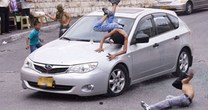
An Israeli military jeep rammed a Palestinian young man and injured him during a campaign at dawn Friday in al-Deheisheh refugee camp, south of Bethlehem.
Local sources told the Palestinian Information Center (PIC) the Israeli occupation forces (IOF) stormed the camp at dawn in a bid to carry out raids on homes and make arrests, but they were confronted by local young men and their campaign went awry.
They added that one of the Israeli military vehicles chased a young men to detain him as it was withdrawing from the camp and ran him over, noting that the young man suffered slight bruises and injuries and was rushed to Beit Jala hospital.
Meanwhile, the IOF stormed the nearby town of Doha and kidnapped 21-year-old Ibrahim Salhab from his home.
Local sources told the Palestinian Information Center (PIC) the Israeli occupation forces (IOF) stormed the camp at dawn in a bid to carry out raids on homes and make arrests, but they were confronted by local young men and their campaign went awry.
They added that one of the Israeli military vehicles chased a young men to detain him as it was withdrawing from the camp and ran him over, noting that the young man suffered slight bruises and injuries and was rushed to Beit Jala hospital.
Meanwhile, the IOF stormed the nearby town of Doha and kidnapped 21-year-old Ibrahim Salhab from his home.

An explosive device detonated at dawn Friday under an Israeli military bulldozer after moving towards the borderline east of Gaza City.
Israeli media sources said that a D-9 bulldozer was seriously damaged after being directly targeted with an explosive device while carrying out combing operations in the area.
Afterwards, the damaged bulldozer was pulled from the area. Israeli army radio reported that no injuries were reported.
Israeli forces have regularly carried out incursions and attacks on the border lines with Gaza in total violation of the ceasefire agreement reached on Aug. 26, 2014. Such violations have had devastating impacts on the Strip’s agricultural fields as farmers’ lives are put in danger on a near-daily basis.
Israeli media sources said that a D-9 bulldozer was seriously damaged after being directly targeted with an explosive device while carrying out combing operations in the area.
Afterwards, the damaged bulldozer was pulled from the area. Israeli army radio reported that no injuries were reported.
Israeli forces have regularly carried out incursions and attacks on the border lines with Gaza in total violation of the ceasefire agreement reached on Aug. 26, 2014. Such violations have had devastating impacts on the Strip’s agricultural fields as farmers’ lives are put in danger on a near-daily basis.
